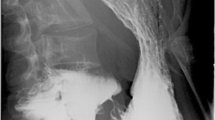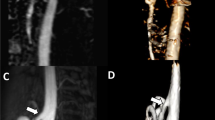Abstract
Purpose
Superior mesenteric artery syndrome (SMAS) is one of the rare causes of chronic duodenal obstruction. The aim of our study was to evaluate the outcomes of surgical management of refractory SMAS (Re-SMAS) in our institution during the last decade.
Materials and Methods
Consecutive patients diagnosed as Re-SMAS and underwent surgical intervention were retrospectively enrolled. A modified Likert-scale-based questionnaire was used to quantify the symptoms of SMAS. The primary outcome was the increase of BMI and symptomatic relief after surgery.
Results
From January 2010 to January 2020, 22 patients diagnosed with Re-SMAS and underwent surgery were included. Age distribution of included patients were < 19 (10/22, 45%), 19–45 (11/22, 50%), and > 45 (1/22, 5%). A significant BMI increase was recorded, [16.1 (14.6–23.7) kg/m2 vs 21.9 (15.6–29.5) kg/m2 before and after surgery, respectively, p < 0.001]. Up to 20 patients (20/22, 91%) reported symptomatic relief. The obstruction-related symptom score decreasing significantly (p < 0.001), with reported nausea, vomiting, and regurgitation incidences dropping from 77 to 41% (p = 0.031), 68 to 23% (p = 0.006), and 32 to 5% (p = 0.046), respectively.
Conclusion
Surgical interventions could relieve obstruction-related symptoms of Re-SMAS and promote weight gain. For patients who suffered from Re-SMAS and referred to surgeons mainly for obstruction-related symptoms, surgical intervention is recommended.
Graphical Abstract



Similar content being viewed by others
Data Availability
The data that support the findings of this study are not publicly available due to their containing information that could compromise the privacy of research participants but are available from the corresponding author (ZQ. W) upon reasonable request.
References
Sun Z, Rodriguez J, McMichael J, et al. Minimally invasive duodenojejunostomy for superior mesenteric artery syndrome: a case series and review of the literature. Surg Endosc. 2015;29(5):1137–44. https://doi.org/10.1007/s00464-014-3775-4.
Lee TH, Lee JS, Jo Y, et al. Superior mesenteric artery syndrome: where do we stand today? J Gastrointest Surg : Off J Soc Surg Aliment Tract. 2012;16(12):2203–11. https://doi.org/10.1007/s11605-012-2049-5.
Mathenge N, Osiro S, Rodriguez II, et al. Superior mesenteric artery syndrome and its associated gastrointestinal implications. Clin Anat. 2014;27(8):1244–52. https://doi.org/10.1002/ca.22249.
Ganss A, Rampado S, Savarino E, et al. Superior Mesenteric Artery Syndrome: a Prospective Study in a Single Institution. J Gastrointest Surg : Off J Soc Surg Aliment Tract. 2019;23(5):997–1005. https://doi.org/10.1007/s11605-018-3984-6.
Fang JF, Wei B, Zheng ZH, et al. Laparoscopic lysis of the ligament of treitz for superior mesenteric artery syndrome. Dig Surg. 2014;31(4–5):291–6. https://doi.org/10.1159/000367670.
Lee CS, Mangla JC. Superior mesenteric artery compression syndrome. Am J Gastroenterol. 1978;70(2):141–50.
Welsch T, Büchler MW, Kienle P. Recalling superior mesenteric artery syndrome. Dig Surg. 2007;24(3):149–56. https://doi.org/10.1159/000102097.
Ahmed AR, Taylor I. Superior mesenteric artery syndrome. Postgrad Med J. 1997;73(866):776–8. https://doi.org/10.1136/pgmj.73.866.776.
Gustafsson L, Falk A, Lukes PJ, et al. Diagnosis and treatment of superior mesenteric artery syndrome. Br J Surg. 1984;71(7):499–501. https://doi.org/10.1002/bjs.1800710706.
Sapkas G, O’Brien JP. Vascular compression of the duodenum (cast syndrome) associated with the treatment of spinal deformities. A report of six cases. Arch Orthop Trauma Surg. 1981;98(1):7–11. https://doi.org/10.1007/bf00389703.
Crowther MA, Webb PJ, Eyre-Brook IA. Superior mesenteric artery syndrome following surgery for scoliosis. Spine (Phila Pa 1976). 2002;27(24):E528-33. https://doi.org/10.1097/00007632-200212150-00023.
Zhu Z, Qiu Y, Wang B, et al. Superior mesenteric artery syndrome following scoliosis surgery: its risk indicators and treatment strategy. Stud Health Technol Inform. 2006;123:610–4.
Bermas H, Fenoglio ME. Laparoscopic management of superior mesenteric artery syndrome. JSLS : J Soc Laparoendosc Surg. 2003;7(2):151–3.
Strong EK. Mechanics of arteriomesentric duodenal obstruction and direct surgical attack upon etiology. Ann Surg. 1958;148(5):725–30. https://doi.org/10.1097/00000658-195811000-00001.
Katayama H, Kurokawa Y, Nakamura K, et al. Extended Clavien-Dindo classification of surgical complications: Japan Clinical Oncology Group postoperative complications criteria. Surg Today. 2016;46(6):668–85. https://doi.org/10.1007/s00595-015-1236-x.
Palanivelu C, Rangarajan M, Senthilkumar R, et al. Laparoscopic duodenojejunostomy for superior mesenteric artery syndrome. JSLS : J Soc Laparoendosc Surg. 2006;10(4):531–4.
Lippl F, Hannig C, Weiss W, et al. Superior mesenteric artery syndrome: diagnosis and treatment from the gastroenterologist’s view. J Gastroenterol. 2002;37(8):640–3. https://doi.org/10.1007/s005350200101.
Ylinen P, Kinnunen J, Höckerstedt K. Superior mesenteric artery syndrome. A follow-up study of 16 operated patients. J Clin Gastroenterol. 1989;11(4):386–91.
Merrett ND, Wilson RB, Cosman P, et al. Superior mesenteric artery syndrome: diagnosis and treatment strategies. J Gastrointest Sur : Off J Soc Surg Aliment Tract. 2009;13(2):287–92. https://doi.org/10.1007/s11605-008-0695-4.
Pottorf BJ, Husain FA, Hollis HW Jr, et al. Laparoscopic management of duodenal obstruction resulting from superior mesenteric artery syndrome. JAMA Surg. 2014;149(12):1319–22. https://doi.org/10.1001/jamasurg.2014.1409.
Chang J, Boules M, Rodriguez J, et al. Laparoscopic duodenojejunostomy for superior mesenteric artery syndrome: intermediate follow-up results and a review of the literature. Surg Endosc. 2017;31(3):1180–5. https://doi.org/10.1007/s00464-016-5088-2.
Bal B, Koch TR, Finelli FC, et al. Managing medical and surgical disorders after divided Roux-en-Y gastric bypass surgery. Nat Rev Gastroenterol Hepatol. 2010;7(6):320–34. https://doi.org/10.1038/nrgastro.2010.60.
Collazo-Clavell ML, Jimenez A, Hodgson SF, et al. Osteomalacia after Roux-en-Y gastric bypass. Endocr Pract. 2004;10(3):195–8. https://doi.org/10.4158/ep.10.3.195.
Stanghellini V, Chan FK, Hasler WL, et al. Gastroduodenal Disorders. Gastroenterology. 2016;150(6):1380–92. https://doi.org/10.1053/j.gastro.2016.02.011.
Martin RJ, Khor TS, Vermeulen T, et al. Wilkie’s syndrome may be due to poor motility. ANZ J Surg. 2005;75(11):1027. https://doi.org/10.1111/j.1445-2197.2005.03603.x.
Barnes JB, Lee M. Superior mesenteric artery syndrome in an intravenous drug abuser after rapid weight loss. South Med J. 1996;89(3):331–4. https://doi.org/10.1097/00007611-199603000-00015.
Pentlow BD, Dent RG. Acute vascular compression of the duodenum in anorexia nervosa. Br J Surg. 1981;68(9):665–6. https://doi.org/10.1002/bjs.1800680918.
Zerańska M, Tomaszewicz-Libudzic C, Jagielska G, et al. Surgical complications occurring during hospitalization of patients with anorexia nervosa–literature review and a discussion of three cases. Psychiatr Pol. 2002;36(4):579–89.
Qu Z, Zheng B, Ju C, et al. Case Report: A Child With Functional Chronic Duodenal Obstruction Caused by Megaduodenum. Front Pediatr. 2020;8:585699. https://doi.org/10.3389/fped.2020.585699.
Funding
The work is supported by Department of Science and Technology of Sichuan Province (No. 2018RZ0091) and West China Hospital of Sichuan University (1·3·5 project of disciplines of excellence- Clinical Research Incubation Project).
Author information
Authors and Affiliations
Contributions
All authors contributed to the study’s conception and design. Material preparation, data collection and analysis were performed by Yu Shen and Tinghan Yang. The first draft of the manuscript was written by Yu Shen and all authors commented on previous versions of the manuscript. All authors read and approved the final manuscript.
Corresponding author
Ethics declarations
Ethical Approval
For this type of study, formal consent is not required.
Informed Consent
Informed consent was obtained from all individual participants included in the study.
Conflict of Interest
The authors declare no competing interests.
Additional information
Publisher's Note
Springer Nature remains neutral with regard to jurisdictional claims in published maps and institutional affiliations.
Key points
• Surgical interventions could relieve the obstruction-related symptoms of Re-SMAS.
• For dyspepsia-related symptoms, Surgical interventions have an indefinite effect.
• Surgery is recommended for Re-SMAS patients with obstruction-related symptoms.
Rights and permissions
Springer Nature or its licensor (e.g. a society or other partner) holds exclusive rights to this article under a publishing agreement with the author(s) or other rightsholder(s); author self-archiving of the accepted manuscript version of this article is solely governed by the terms of such publishing agreement and applicable law.
About this article
Cite this article
Shen, Y., Yang, T., Meng, W. et al. Surgical Intervention Could Relieve Obstruction-Related Symptoms of Refractory Superior Mesenteric Artery Syndrome: Long-Term Follow-up Results. OBES SURG 33, 1073–1082 (2023). https://doi.org/10.1007/s11695-023-06478-6
Received:
Revised:
Accepted:
Published:
Issue Date:
DOI: https://doi.org/10.1007/s11695-023-06478-6




